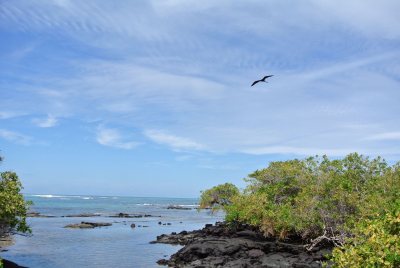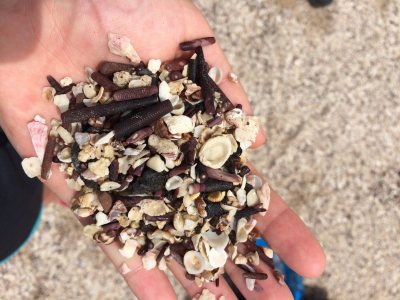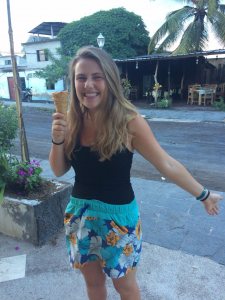A Trek to Remember: Wall of Tears
Written by: Adelae, Class of 2019, Neuroscience major
Today we biked to the Wall of Tears and made observations about the biotic and abiotic interactions of this environment.
Today we biked (well, I walked with my trusty trekking poles) to the Muro de las Lágrimas, or the Wall of Tears. This was an 8 km bike ride from IOI, our base camp on Isabela. The trail is a rocky one made of gravelly basaltic lava. After reaching the Wall of Tears we completed a short hike that lead to a beautiful view of the beaches of Isabela. Prisoners in a penal colony throughout the years (1944-1959) built the wall from lava rock. To the prisoners’ dismay, it was constructed and destroyed each day to keep the prisoners busy. The wall stands about 5 m tall, 3 m wide, and 100 m long.
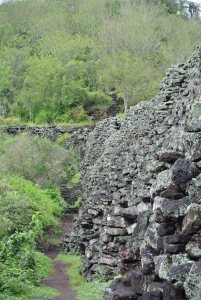
Pictured above is the Wall of Tears. Given the age of the lava rock, lichens have begun to spot the wall, giving it the slightly greenish tinge. We climbed up the stairs on the far end of the wall for our hike.
On our way to the Wall of Tears we were fortunate enough to see five dome-backed tortoises. Two of them were fighting, one was slowly making its way to feed, and two others were feeding on the leaves on the low hanging plants. The vegetation on this trip was very lush and densely packed with trees, definitely one of the greener places I have experienced in the Galápagos thus far. We saw many candelabra and prickly pair cacti as well as various soil types. Due to the abundance of vegetation and flowering plants and leaves in this El Niño year, we were able to see many of Darwin’s famous finches! As a side note, one should know that Darwin did not take particular interest in these guys. During his collecting he simply stowed them away, failing to label which island the finches originated from. Today we saw the small and medium ground finch, the Cactus finch, the small tree finch, and the warbler finch. All were busy feeding on the plentiful seeds available to them.
After successfully reaching the Wall of Tears, we were all quite sweaty and sticky. The sweltering sun here at the equator began to kick in, but we were all eager to continue up to the top. The view did not disappoint! From the top we saw some very young lava flows and the crystal clear turquoise ocean. Being at the highest elevation we have been thus far, we saw some plant life we had not previously encountered, including a plant called sedge, which looks like a small star shaped version of a cattail.
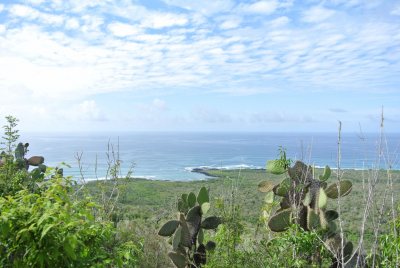
View from the summit of the Wall of Tears trail. You can see prickly pear cacti, which Darwin’s finches and saddle-backed tortoises enjoy eating the fruits from!
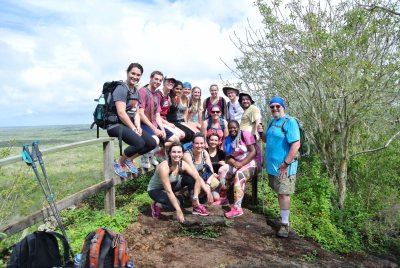
Class photo, glistening and a little red, on the Wall of Tears trail. Happy and sweaty, our words for the day!
After spending some time at the top, we made our way back down and visited La Playa del Amor, or the Love Beach. This beach is unique because the sand there is comprised entirely of dead sea-urchin shells and spines from pencil sea urchins, giving the sand a purple tinge. We were also able to observe the aggressive behavior of the damselfish in the tidal pool, and see our favorite and colorful Sally lightfoot crabs move about the rocky lava.
After our trip, some of us headed to the beach for a refreshing swim, went to our host families house to relax and cool off, or the best option, which is what I did, and rewarded myself with a delicious chocolate-banana milkshake. This afternoon we spent time working on data from the bird survey we conducted yesterday while motoring around Tortuga Island. We were able to find significant zonation patterns and learn a great deal about the ideal habitats for various bird species such as the Nazca booby and the frigate. Following or afternoon in the classroom, many of us enjoy providing the local bakery with our hungry bellies and reliable business. We’d like to think we are regulars now, and we are so surprised these delicious treats only cost $1 each! Needless to say we never go hungry here on Isabela.
Tonight we will gear up for our Community Engaged projects beginning tomorrow! We will be learning about endemic and invasive species and helping the community to get rid of these invasive and harmful plants. I think I speak for most of us when I say we are all eager for a day or two on land, especially after yesterday’s bumpy ride and what will be our sore legs tomorrow. Until next time, ciao from Isabela!
